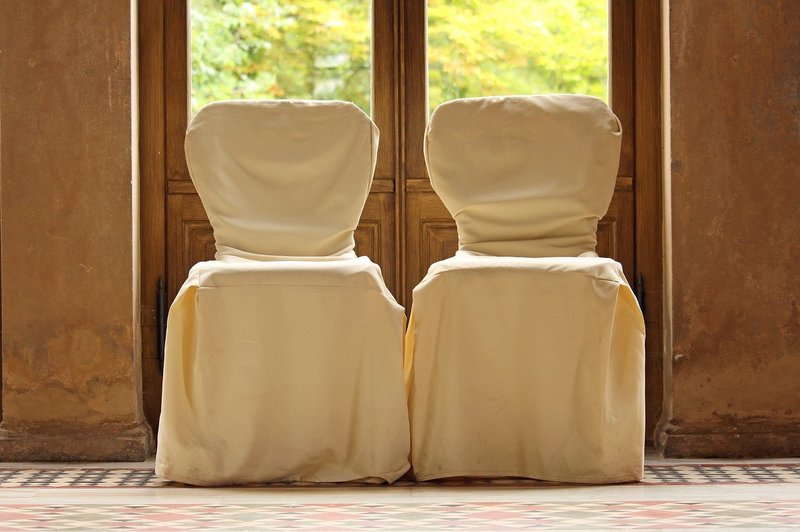In this article, we’re going to help you protect your chairs by sharing how to make a slipcover for a chair by sewing! We’ll also share the types of fabric that fit different kinds of chairs and how to determine the yards of fabric you need. Stick until the end, and you’ll learn about how to do a non-sew method of doing a chair slipcover.

Steps On Making A Slipcover For A Chair
Step #1. Prepare the materials
First, prepare your measuring tape since you are going to measure your chairs thoroughly. Then, prepare your sketch, pins, fabric, scissors, and sewing materials (thread and sewing machine).
Step #2. Measure the chair
Before buying your fabric, you have to measure your chair first. This is to gauge how much material you’ll need and prevent additional trips to the store or ending up with a ton of leftover fabric.
Note that if your cloth of choice has a pattern, then you’d want to match the lines. This means that you’d need to buy extra material for your slipcover.
Measure your chair from the bottom at the back to its front side, along with the “L” side. You can sketch your chair and place the measurements alongside it for reference.
Step #3. Pick a fabric
After taking your chair’s measurements, you can now pick your fabric. The type of fabric you need is based on the kind of chair you want to make a slipcover. After choosing your material, choose a matching spool of thread.
You have to consider if they are located in a heavy or low traffic place for your living room chairs. If you are decorating for an event, ask yourself if the theme is casual or formal.
Now, let’s talk about making the chair slipcovers for a piece of furniture.
For low-traffic areas, quilting cotton may be a good choice due to its drape. It also has enough stretch, which makes it a great slipcover. However, it is not durable, hence why it’s recommended only for low traffic areas, like your bedroom.
If you want easily washed covers that can maintain their durability, you can opt for canvas. They are budget-friendly and can be used for high-traffic areas.
Step #4. Pattern
Your sketch is useful when you’re creating a pattern. Transfer the measurements you’ve made for your chair onto your fabric and mark them. After marking them:
- Check if the cloth can fully cover the chair’s dimensions and make necessary adjustments.
- Consider the pattern of the fabric as well while you’re checking its fit on your chair.
- Leave inches of the material for hemming.
Step #5. Cut and pin
Next, cut your fabric according to your pattern. Leave an inch for seam allowance.
Next, place the material on your chair, then pin edges together, with the wrong side up. Aim for a tight fit by keeping your pins close to the chair. When you encounter your chair’s contours, fold the fabric a bit.
Step #6. Sew, fit, and restitch
Slowly remove your pinned fabric from the chair, then take it to your sewing machine. Take out each pin as you stitch your way through the material.
Leave the bottom edge unstitched. Afterward, fit the slipcover with the right-side-up on the chair. Restitch areas that seem too loose or too tight.
Step #7. Do the hems and trim
After fitting the slipcover, hem the bottom edge. Fold the material over twice and stitch the bottom.
How many yards of fabric do you need for a chair slipover?
For no-repeat fabrics, here is an approximate breakdown of fabric yardage you need for a chair slipcover:
- Dining room chair (three yards of 45” wide or 60” wide fabric)
- Standard armchair (eight to ten yards of 45” wide fabric or four to six yards of 60” wide fabric )
- Ottoman (two yards of either 45” or 60” wide fabric)
Is it possible to make a no-sew slipcover?
For a no-sew slipcover, you will need adhesives and pins instead of sewing materials. The steps are the same as the sewing method, except for the sewing part.
Instead, you are going to apply the no-sew adhesive at the hems of the fabric after ironing them flat. Then, join the material together by pressing the hems.
Then, fit the fabric onto the chair and adjust as needed. Use safety pins on the crevices, and hide them with accessories like buttons. Finally, secure the whole slipcover with safety pins.
Conclusion
Knowing how to make a slipcover for a chair can be helpful when you want to change your chairs’ look or hide worn-out parts of them. It can also be helpful for parties to decorate your otherwise simple-looking chairs into something more elegant.
With this article, we hope that you were able to learn about the two methods of making a chair slipcover, the fabric you need for it, and many more!
